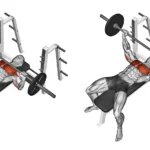Dumbbell Shrug: Exercise Overview
The dumbbell shrug is a targeted isolation exercise designed to build and strengthen the trapezius muscles, particularly the upper traps, which contribute to a powerful and defined upper back. Unlike barbell shrugs, the dumbbell variation allows for a greater range of motion and unilateral focus, helping to address imbalances in trap development.
As a stubborn muscle group for many lifters, the traps often benefit from frequent training with varied intensity, volume, and equipment (Schoenfeld, 2010). The dumbbell shrug is a versatile movement that can be incorporated into shoulder workouts, back-focused sessions, upper-body routines, or full-body training programs, supporting both aesthetic goals and functional shoulder strength (Wirth et al., 2016).
How to Perform the Dumbbell Shrug
- Stand with feet hip-width apart, holding a dumbbell in each hand with a neutral grip (palms facing your body), letting the weights hang at your sides.
- Maintain a neutral spine, engage your core, and keep your shoulders relaxed—this is your starting position.
- Elevate your shoulders by contracting your traps, lifting the dumbbells as high as possible without bending your arms.
- Pause briefly at the top, squeezing your traps to maximize muscle engagement.
- Lower the dumbbells back to the starting position with control, keeping tension in the traps.
- Repeat for the desired number of repetitions.
Tips for Optimal Performance
- Control the Movement: Perform the shrug slowly and deliberately to maximize trap activation and avoid momentum, reducing the risk of neck or shoulder strain (McGill, 2010).
- Pause at the Top: Hold the top position for 1–2 seconds to enhance the mind-muscle connection and increase muscle activation (Schoenfeld, 2016).
- Adjust Head Position: Slightly tilt your head upward to enhance trap contraction, but avoid jutting your chin forward to prevent neck strain (Wirth et al., 2016).
- Program for High Reps: Traps often respond well to higher rep ranges (e.g., 12–20) or explosive variations like snatch-grip high pulls, so tailor your sets to your goals.
- Maintain a Neutral Spine: Brace your core to keep your back straight, avoiding excessive arching or rounding during the movement.
- Breathe Properly: Exhale as you shrug your shoulders upward and inhale as you lower the dumbbells to support controlled movement and muscle oxygenation.
Building traps with dumbbell shrugs? Learn how they enhance your back in our Ultimate Guide to Muscle Groups.







